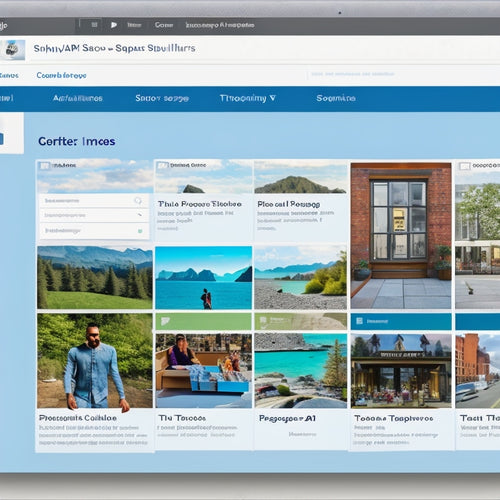
Optimize Online Store Performance With Proven Tools
Share
To optimize your online store's performance, you need to identify and tackle pain points like high shipping costs, complex checkout processes, and lack of trust, which contribute to a staggering 69.57% cart abandonment rate. Proven tools like Google Analytics, Hotjar, and Optimizely can help you track performance, analyze sales funnels, and boost conversion rates. By streamlining your order fulfillment process, refining your site's navigation, and making data-driven decisions, you can greatly enhance customer experience and satisfaction. Now, take the next step to uncover more strategies and tools to supercharge your online store's performance.
Key Takeaways
• Utilize performance tracking tools like Google Analytics and Hotjar to identify areas for improvement in your online store.
• Leverage ecommerce analytics platforms such as RJMetrics and Glew to gain data-driven insights into customer behavior and sales funnel performance.
• Implement marketing automation software like Klaviyo and Octane AI to streamline and optimize your marketing efforts.
• Conduct A/B testing and conversion rate optimization with tools like Optimizely and VWO to increase conversions and revenue.
• Analyze user interaction and behavior to refine your site's navigation, content, and design, enhancing user experience and satisfaction.
Ecommerce Pain Point Identification
To optimize your online store's performance, you must first identify the ecommerce pain points that are hindering your sales, conversions, and customer satisfaction. Cart abandonment is an important pain point, with an average rate of 69.57%. You need to analyze why customers are leaving their carts behind. Is it due to high shipping costs, complex checkout processes, or lack of trust in your website? Understanding the reasons will help you develop targeted strategies to reduce cart abandonment rates.
Another vital ecommerce pain point is customer retention. You've invested significant resources in acquiring new customers, but are you doing enough to keep them coming back? Customer retention rates are a key indicator of your online store's performance. You need to track metrics such as customer lifetime value, repeat purchase rates, and customer satisfaction scores to identify areas for improvement.
Download Ecommerce Business Optimization Tools
You've identified the ecommerce pain points hindering your online store's performance, and now it's time to equip yourself with the right tools to tackle them, starting with downloading ecommerce business optimization tools that can help you streamline processes, analyze customer behavior, and boost conversions.
To get started, download the following essential tools:
-
Performance tracking tools: Google Analytics, Mixpanel, or Hotjar to monitor your website's performance, track user behavior, and identify areas for improvement.
-
Ecommerce analytics platform: Tools like RJMetrics or Glew to analyze sales data, track customer lifetime value, and optimize your pricing strategy.
-
Marketing automation software: Platforms like Klaviyo or Octane AI to automate email marketing campaigns, personalize customer experiences, and drive revenue optimization.
- Conversion rate optimization tools: Tools like Optimizely or VWO to run A/B tests, identify winning variations, and maximize conversions.
Analyze Sales Funnel Performance
With your optimization tools in place, it's time to plunge into the nitty-gritty of analyzing your sales funnel performance, where every conversion counts and data-driven insights can make all the difference. You're now equipped to dive deeper into the performance of each stage of your sales funnel, identifying areas that need improvement and opportunities to optimize.
Start by conducting a thorough conversion rate analysis to pinpoint where customers are dropping off. Are they abandoning their carts at checkout, or are they getting stuck on a specific product page? Use this data to inform your funnel optimization strategy, making targeted tweaks to improve the user experience and increase conversions.
Next, utilize user behavior tracking to gain a deeper understanding of how customers interact with your site. This will help you identify pain points and areas of friction in the sales funnel, allowing you to make targeted improvements that drive real results.
Streamline Order Fulfillment Process
Optimize your order fulfillment process by implementing efficient shipping strategies, automating order tracking, and integrating inventory management systems to reduce delays and errors. This won't only improve customer satisfaction but also increase your online store's overall performance.
To take your order fulfillment process to the next level, focus on the following key areas:
-
Automate shipping: Integrate shipping automation tools to print shipping labels, track packages, and update order status in real-time.
-
Implement inventory management: Use inventory management systems to track stock levels, prevent overselling, and optimize inventory replenishment.
-
Streamline order tracking: Automate order tracking notifications to keep customers informed about their order status, reducing support queries and improving customer satisfaction.
- Analyze fulfillment metrics: Monitor key fulfillment metrics such as shipping speed, order accuracy, and inventory turnover to identify areas for improvement.
Boost Conversion Rate Optimization
By pinpointing and addressing friction points in the checkout process, you can greatly increase the likelihood of converting browsers into buyers. To do this, you'll need to analyze your customer journey to identify areas where potential customers are dropping off. This can be achieved through customer journey analysis, which involves mapping out each step of the buying process to identify pain points.
Next, use A/B testing strategies to validate your hypotheses and implement data-driven optimization tactics. For instance, you might test different checkout layouts, call-to-actions, or payment options to see which ones yield the highest conversion rates.
Identify Product Page Issues
You can significantly improve the shopping experience and drive sales by examining your product pages for defects, inconsistencies, and areas of improvement that may be deterring customers from making a purchase. By doing so, you'll identify opportunities to optimize your product pages and increase conversions.
Here are key areas to focus on:
-
Product images and descriptions: Verify they're high-quality, precise, and concise. Low-quality images or unclear descriptions can lead to uncertainty, causing customers to abandon their carts.
-
Mobile responsiveness: With most online shopping happening on mobile devices, it's essential that your product pages are optimized for mobile. Test your pages on various devices to guarantee a seamless experience.
-
Load times: Slow load times can result in high bounce rates. Enhance your images, compress files, and utilize browser caching to reduce load times.
- CTA placement and design: Confirm your call-to-action (CTA) buttons are prominent, clear, and easy to click. A poorly designed CTA can result in missed conversions.
Enhance Customer Experience Tools
To take your online store to the next level, implement customer experience tools that provide personalized product recommendations, intuitive search functionality, and real-time inventory updates to streamline the shopping process. By doing so, you'll increase customer satisfaction, reduce cart abandonment rates, and boost sales.
To further enhance customer experience, incorporate A/B testing techniques to refine your user interface enhancements. This will help you identify which design elements resonate with your target audience, ensuring a seamless and engaging shopping experience.
Additionally, leverage social media integration to create a cohesive brand presence across all platforms.
To maximize customer retention, develop and execute targeted customer retention strategies. This may include loyalty programs, exclusive offers, and personalized communication. By prioritizing customer experience, you'll build a loyal customer base that drives repeat business and fuels long-term growth.
Monitor Website Performance Metrics
Your online store's performance metrics provide a wealth of data-driven insights to optimize its overall functionality, identify areas of improvement, and inform data-backed decisions.
By monitoring these metrics, you can make strategic adjustments to boost conversions, enhance user experience, and drive revenue growth.
Here are four key performance metrics to focus on:
-
Website speed tracking: Monitor your site's loading speed to verify it's not driving away potential customers. Aim for a loading time of under 3 seconds.
-
Conversion rate monitoring: Track your conversion rates to pinpoint areas where customers are dropping off. Analyze this data to optimize your checkout process and improve user experience.
-
User experience analysis: Study how users interact with your site to pinpoint pain points and areas for improvement. This data can help you refine your site's navigation, content, and overall design.
- Performance benchmarking: Compare your site's performance to industry benchmarks to verify you're meeting customer expectations. This data can help you pinpoint areas where you need to improve to stay competitive.
Frequently Asked Questions
Can I Use These Tools for My Physical Storefront as Well?
While you're crushing it online, you're wondering if these digital dynamos can boost your brick-and-mortar game too. Absolutely! You can leverage in-store analytics to enhance customer engagement, track foot traffic, and streamline inventory management for a seamless retail experience.
Are These Optimization Tools Compatible With My Ecommerce Platform?
You'll be glad to know that our optimization tools are compatible with most ecommerce platforms, ensuring seamless integration. We'll work with you to determine a performance improvement timeline, tailoring our solutions to your specific needs for maximum ROI.
How Long Does It Take to See Noticeable Performance Improvements?
"Implementing optimization tools is like flipping a switch - you'll see noticeable performance improvements quickly. You'll be tracking progress in days, not weeks, and analyzing results to boost user experience, conversion rates, and ultimately, your bottom line."
Will These Tools Help Me Reduce My Website's Bounce Rate?
You'll likely see a bounce rate reduction by leveraging these tools for bounce rate analysis, as they'll help you identify and fix user experience issues, improving your website design and boosting conversion rate optimization.
Are There Any Free Trials or Demos Available for These Tools?
You're wise to test the waters before diving in! Yes, most tools offer free trials or demos, allowing you to compare pricing, explore features, and assess customer support before committing to the best fit for your online store.
Related Posts
-

5 Best Online Course Strategies for Ecommerce Success
You're about to reveal the secrets to creating an online course that drives real ecommerce results, one that resonate...
-

Assessing Ecommerce Digital Literacy for Merchant Success
You're already operating an ecommerce store, which means you're well aware of the importance of digital literacy in d...
-

How Do I Set up A Tracking Page on Shopify
This article aims to provide a comprehensive guide on setting up a tracking page on the Shopify platform. It explore...


